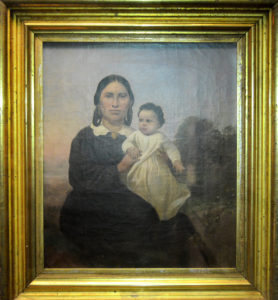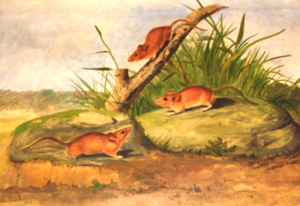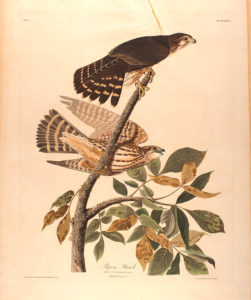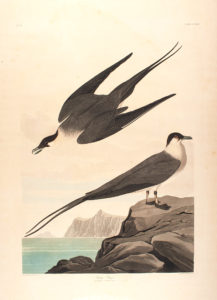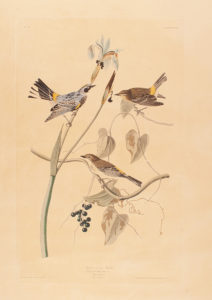- 270-826-2247
- audubonfriends@gmail.com
Adopt-an-Artwork
About the Program
Audubon is synonymous with conservation. The John James Audubon Museum boasts one of the world’s largest collections of Audubon art and memorabilia—most of which was loaned to the Museum in 1938 and later purchased through a grassroots fundraising campaign in the local community. Now, as the collection continues to grow in pieces and value, our focus turns to conservation. The purpose of the Adopt-an-Artwork program is to address the declining state of a number of significant objects in the collection through immediate care and professional preservation. The program is supported by compassionate individuals who want to see these important pieces preserved for future generations. Many items in our collection are the only item of its kind in the world. If not properly preserved now, the world will lose a piece of Audubon’s story forever.
On this page you will find artworks up-for adoption. As part of the adoption process, you will be recognized with a plaque hung under the adopted piece when on display in the Museum gallery and receive a color photo of your adopted artwork. Please know that you don’t have to adopt an artwork on your own. You and your friends, family, company or other interested parties may jointly adopt an artwork.
Can’t decide on a piece to adopt? Consider donating to the Friends of Audubon general art conservation fund. The Museum Curator will use your donation toward the adoption of the highest priority conservation piece.
For more information about the Adopt-an-Artwork Program and donating to the art conservation fund, contact the Audubon Museum at (270) 826-2247.
Artworks Available for Adoption
Natawista Culbertson
1843
by John James Audubon
Natawista Culbertson, a Kainah interpreter and diplomat, hosted Audubon and his son during their stay at Fort Union. This painting is believed to be one of Audubon’s last oil portraits. Audubon began to lose his eyesight shortly thereafter and could no longer paint.
Cost: $1,200
Missouri Mouse
1843
By John Woodhouse Audubon
Audubon's youngest son, John Woodhouse, was a talented artist in his own right. John assisted his father in the production of Birds of America and created about half of the artwork for The Viviparous Quadrupeds of North America — Audubon's second monumental publication. The Missouri Mouse is one of two original oil paintings by John Woodhouse available for adoption. At some point this painting's canvas was removed from its original stretcher and placed onto another one 5/8" taller than the original. The painting's surface plane is poor and distorted by slagging because of the ill-fitting stretcher. The surface is covered with a heavy deposit of airborne grime, resulting in a grey pall over the image. The proposed treatment is to return the painting to its original dimension, a bit smaller than what it is now, and thoroughly clean the painting.
Cost: $1,900
Orange-Colored Mouse
1846
By John Woodhouse Audubon
This original oil painting by Audubon’s son, John Woodhouse, is in extremely fragile condition and cannot be exhibited in its current shape. The painting's surface plane is poor, deformed by sagging against the original stretcher and by numerous ripples and draws. The surface is covered with a thick discolored varnish and with sooty airborne grime resulting in a yellow-grey pall over the image. The fragility of the canvas and paint layers requires that the structure of the painted be reconsolidated. The recommended treatment is to reline the painting using an appropriate adhesive and remount it on its present stretcher. Losses would be filled and inpainted, and the surface would be cleaned and receive a protective varnish.
Cost: $1,800
Pigeon Hawk
Ca. 1832
By Robert Havell, Jr. after John James Audubon
This is an original hand colored engraving from Audubon’s groundbreaking work, The Birds of America. The paper conservator hired to do the work recommends the following treatment: surface cleaning to reduce grime; washing the print to remove acids from the paper to improve paper flexibility; using local stain reduction to lighten stained areas; mending tears using Japanese paper and an appropriate adhesive; filling losses using wove paper or paper pulp as appropriate; and humidifying and drying the print in a pressing stack to reduce planar distortion. Once repaired, the engraving will be in rotation with other prints on exhibit at the John James Audubon Museum. Information and image courtesy of Dawn Heller of Heller Conservation Services.
Cost: $900 – $1,530
Artic Jager
1835
By Robert Havell, Jr. after John James Audubon
This is an original hand colored engraving from Audubon’s groundbreaking work, The Birds of America. The paper conservator hired to do the work recommends the following treatment: surface cleaning to reduce grime; washing the print to remove acids from the paper to improve paper flexibility; mending tears using Japanese paper and an appropriate adhesive; humidifying and drying the print in a pressing stack to reduce planar distortion. Once repaired, the engraving will be in rotation with other prints on exhibit at the John James Audubon Museum. Information and image courtesy of Dawn Heller of Heller Conservation Services.
Cost: $810 – $1,050
Yellow-crown Warbler
Ca. 1832
By Robert Havell, Jr. after John James Audubon
This is an original hand colored engraving from Audubon’s groundbreaking work, The Birds of America. The paper conservator hired to do the work recommends the following treatment: surface cleaning to reduce grime; mechanically reducing pressure sensitive tape residues; washing the print to remove acids from the paper to improve paper flexibility; mending tears using Japanese paper and an appropriate adhesive; humidifying and drying the print in a pressing stack to reduce planar distortion; using local stain reduction to lighten stained areas; filling losses using wove paper or paper pulp as appropriate. Once repaired, the engraving will be in rotation with other prints on exhibit at the John James Audubon Museum. Information and image courtesy of Dawn Heller of Heller Conservation Services.
Cost: $1,200 – $1,680

